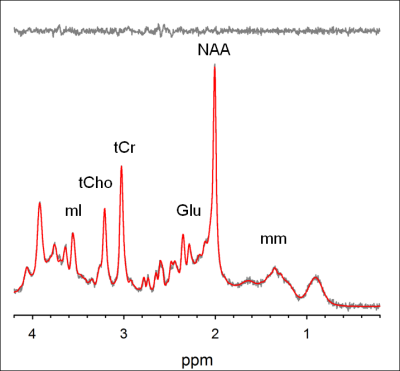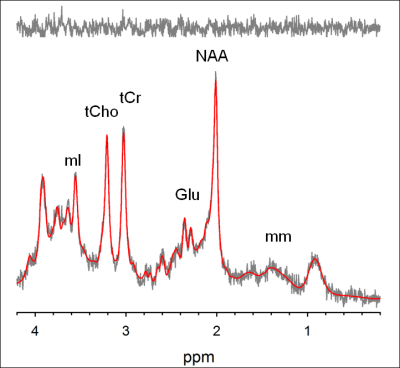Frank E. Gaston1, S. Andrea Wijtenburg1, Stephanie A. Korenic1, Hongji Chen1, and Laura M. Rowland1
1Psychiatry, University of Maryland School of Medicine, Baltimore, MD, United States
Synopsis
MRS was used to examine the aging effects of
glutamate in participants with schizophrenia versus healthy controls. The
parietal lobe and hippocampus, regions associated with general aging and
the pathophysiology of schizophrenia, were assessed. Results revealed that
hippocampal glutamate was lower in older adults with schizophrenia versus older
controls. In contrast, parietal glutamate was lower in schizophrenia versus
controls, irrespective of age group. These results suggest that the hippocampus
may be particularly vulnerable to aging in schizophrenia. Interventions that
halt hippocampal glutamate decline may be beneficial for patients with
schizophrenia.
Target Audience
Researchers
interested in studying schizophrenia using MRSIntroduction
Glutamate, the
primary excitatory neurotransmitter in the human brain, may decline with age at
a greater rate in schizophrenia compared to the general population as suggested
by meta-analysis1. A recent magnetic resonance spectroscopy (MRS)
study examining the anterior cingulate showed that glutamate declined with age at
similar rates in both schizophrenia and healthy controls2. However, it
is unclear whether this pattern is isolated to a specific brain region or
widespread to other brain regions. Here, we used MRS to investigate glutamate
levels in the parietal lobe and hippocampus, regions implicated in the
pathophysiology of schizophrenia and general aging.Methods
All data were
acquired on a Siemens TIM Trio 3T MR system with a 32-channel head coil. The
study was approved by the UMB IRB. All participants provided written informed
consent. Eighty-six participants completed the study. Participants with schizophrenia
were evaluated for psychopathology, and all participants completed cognitive
testing with a focus on relational memory, which is hippocampal dependent. MPRAGE
images were acquired in order to prescribe the MRS voxels in the hippomcampus
(VOI~4.5cm3) and parietal lobe (VOI~6cm3) (Figures 1
& 2). Data were acquired using PRESS: TR/TE=2000/30ms, NEX=256/hippocampus
and 128/parietal, spectral width=2.5kHz, and 2048 complex points. A water
reference (NEX=16) was acquired as well for phase and eddy current correction. Glutamate
was quantified using LCModel3, and Cramer Rao Lower Bounds (CRLB) standard
deviation (SD) thresholds were ≤ 20% for glutamate. All data were corrected for
the proportion of proportion of gray matter, white matter, and CSF within the
spectroscopic voxel using Matlab code based on the work of Gasparovic et al4.
Metabolite levels were reported in institutional units. Two-way ANOVAs with
diagnosis and age as main effects were computed. Correlation analyses were conducted
between glutamate and relational memory measures.Results
Representative
spectra from each region as well as the corresponding LCModel fit and residual are
shown in Figures 3 & 4. Hippocampal glutamate was lower in schizophrenia
versus healthy controls (p=0.041). More specifically, glutamate was
significantly lower in older adults with schizophrenia compared to healthy
controls (p=0.005), and this was not observed when comparing young adults with
schizophrenia and healthy controls (p=0.844). In the parietal lobe, glutamate
was lower in older versus younger groups (p<0.001). . Parietal glutamate was
lower in participants with schizophrenia compared to controls (p=0.042)
irrespective of age group. Better relational memory performance was related to
higher levels of parietal glutamate (p<0.01). There were no significant
relationships between glutamate levels in either region and severity of
psychiatric symptoms.Discussion
These results, in
conjunction with previous work2, suggest that anterior cingulate and
parietal cortical regions do not show accelerated aging in schizophrenia but do
show reduced glutamate levels in the illness. In contrast, the hippocampus may
be particularly vulnerable to aging in schizophrenia since lower hippocampal
glutamate levels were observed only in older participants with schizophrenia.
Interventions targeted at increasing levels in the anterior cingulate and
parietal cortex and halting the decline in the hippocampus may be beneficial
for patients with schizophrenia.Acknowledgements
This study was
supported by the National Institute Health: R01MH094520.References
1Marsman A et al. Glutamate in schizophrenia: a
focused review and meta-analysis of 1H-MRS studies. Schizophr Bull 2013.
39:120-9. 2Wijtenburg SA et
al. Altered glutamate and regional cerebral blood flow levels in schizophrenia:
a 1H-MRS and pCASL study. Neuropsychopharmacology. 2017. 42:562-71. 3Provencher SW. Estimation of
metabolite concentrations from localized in vivo proton NMR spectra. Magn Reson
Med 1993;30(6):672-679. 4Gasparovic C et al. Use of tissue water as
a concentration reference for proton spectroscopic imaging. Magn Reson Med 2006;
55(6): 1219-1226.



